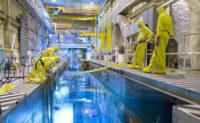
From a plateau created by a rock cut made in 1984, when Brazil first started construction on the 1,405-MW Angra 3 nuclear powerplant unit, there is a commanding view of the jobsite where work has now resumed after more than a two-decade lapse.
Angra 3, built using the pressurized-water-reactor design, now is set to operate in 2015 at a cost of about $5.6 billion. It will join two other smaller units, Angra 1 and 2, that were completed decades ago. Work on the newest plant was shut down in 1986 due to Brazil's financial constraints but was resumed in 2010.
While hydroelectric provides about 80% of Brazil's power and nuclear less than 5%, officials of Eletronuclear, the nuclear power unit of state-owned utility Eletrobras, say the country's hydropower resources could be tapped by 2030 and that they expect more restrictions on land use in the Amazon region, according to a published report.
The government has plans to build four more nuclear units totaling 4,000 MW, although it delayed announcing them last year after the Fukushima nuclear plant disaster in Japan in March 2011.
With its technically complex construction enclosed in a concrete container that will house nuclear power-generating equipment, the Angra 3 jobsite in Itoarna, about 130 kilometers from Rio de Janeiro, is small compared to that of a hydroelectric plant. Now employing 4,000 people, the project is part of the Brazilian government’s Growth Acceleration Program.
José Eduardo Costa Mattos, an engineer with Eletronuclear/Eletrobrás, says that construction of Angra 3 is being managed by Areva NP, the successor to its original builder, Siemens/KWU, which also built the first two Angra units.
But since work was halted in 1986, keeping the site in a “ready” state has cost the government hundreds of millions in jobsite maintenance, storage of equipment and materials purchased as far back as the 1970s, security and periodic preventive inspections.
In 2006, the Brazilian Institute for the Environment and Renewable Natural Resources (IBAMA) required Eletronuclear to design a plan to recover degraded areas at the site, including draining the plant’s original foundation pit and taking action to protect the rock mass. The site chosen for the plant’s new location offered more favorable foundation conditions.
Three concrete plants operate at the jobsite with a total capacity of 230 cu meters of production per hour. There also are four ice plants that produce a total of 25 tons an hour. A 600-ton Manitowoc crane moves into place the containment structure's segments, some as heavy as 37 tonnes.
Construction and equipment installation requires extreme precision because key areas of the containment structure will then become inaccessible to crews. Rejected site materials and waste must be stored at special site locations.
Engineer Eletronuclear engineer Costa Mattos says that, despite the gap in in its nuclear construction program, Brazil has the engineering know-how to build Angra 3 and the other planned nuclear units. The Angra 1 plant has been in commercial operation for more than 25 years and Angra 2 for over a decade.
Eletrobras, which spent about $327 million on Angra 3's early development, is seeking funds from private sources to complete the project. Published reports say the Russian government has expressed interest in the project and that it has received a $3.6- billion, 20-year loan from Brazil's national development bank, BNDES.


Post a comment to this article
Report Abusive Comment